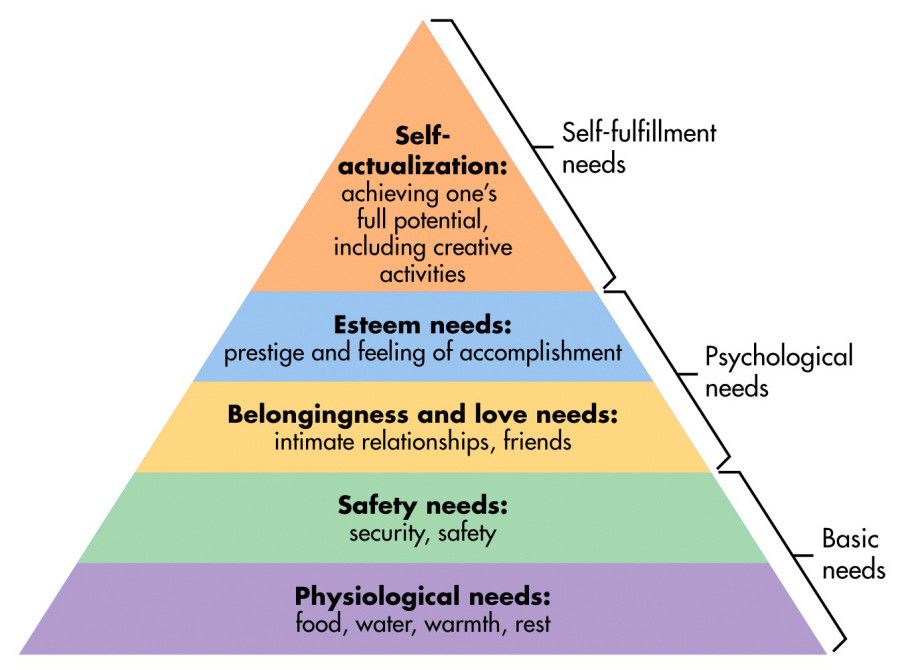What Is Self-Actualization? Meaning, Theory + Examples
 The concept of self-actualization was brought into the mainstream by Abraham Maslow when he introduced his “hierarchy of needs.”
The concept of self-actualization was brought into the mainstream by Abraham Maslow when he introduced his “hierarchy of needs.”
Today, self-actualization is a bit more widely known, but most psychology students still learn of it as the top level of Maslow’s pyramid.
This article will define self-actualization, review the relevant research on self-actualization, and discuss its relevance to the positive psychology movement and to the average person.
Before you continue, we thought you might like to download our three Self-Compassion Exercises for free. These detailed, science-based exercises will not only help you increase the compassion and kindness you show yourself but will also give you the tools to help your clients, students, or employees show more compassion to themselves.
This Article Contains:
What is Self-Actualization? A Definition
Although self-actualization is most often associated with Maslow, the term was first coined by Kurt Goldstein. Goldstein characterized self-actualization as an individuation, or process of becoming a “self,” that is holistic (i.e., the individual realizes that one’s self and one’s environment are two pieces of a greater whole) and acts as a primary driving force of behavior in humans (Whitehead, 2017).
Although Goldstein’s concept didn’t get much traction at the time, it was popularized when Maslow adopted it into his theory on the human hierarchy of needs. In his seminal paper about human motivation (in which he first introduced his hierarchy of needs), Maslow discussed self-actualization by stating, “What a man can be, he must be. This need we may call self-actualization” (Maslow, 1943).
Self-actualization has also been described as:
the psychological process aimed at maximizing the use of a person’s abilities and resources. This process may vary from one person to another
(Couture et al., 2007).
In other words, self-actualization can generally be thought of as the full realization of one’s creative, intellectual, and social potential through internal drive (versus for external rewards like money, status, or power).
Since self-actualization is based on leveraging one’s abilities to reach their potential, it is a very individual process and will probably vary significantly from person to person. This focus on individual motivations is a key part of Maslow’s work, and what he felt differentiated it from the contemporary motivational psychology.
Abraham Maslow
As you may already know, Abraham Maslow was a prominent psychologist most known for his contributions to humanistic psychology. His interests in human motivation and self-actualization stemmed from his experiences both early on as a timid child, and later on as a father witnessing the horrors of World War II (Frick, 2000; Hoffman, 2008).
His hierarchy of needs–first introduced over 70 years ago–is still taught as a critical part of motivational psychology. In fact, there is a noticeable overlap between Maslow’s work and the work that underpins positive psychology (Goud, 2008); the emphasis on self-growth and self-development has a decidedly “positive” flavor to it.
The Theory of Self-Actualization and the Hierarchy of Needs
Maslow’s idea of self-actualization has far-reaching applications, but it should be considered within the context of his hierarchy of needs.
Maslow felt that human motivation needed to be studied beyond the contemporary scope of behaviorism, as he believed that the study of “[m]otivation should be human-centered rather than animal-centered” (Maslow, 1943).
Maslow first outlined his hierarchy of needs in his seminal 1943 paper on human motivation. He identified five needs:
- Physiological
- Safety
- Love
- Esteem
- Self-actualization
Physiological needs refer to things that are necessary for survival, such as breathable air, food, and water. Safety needs are things that make you feel healthy (like having health care and knowing your water is clean) and physically safe (like adequate shelter or being in a large group).
Love needs are met through feeling liked, loved, and accepted by others. Esteem is achieved by feeling self-confident and respected by others. Finally, self-actualization needs are met when an individual engages in self-development and personal growth.
Maslow posited that each level of needs must be taken care of before the next one can be met. So, fulfilling one’s physiological needs is a prerequisite to their safety needs being met; one’s safety needs must be met before one’s love needs take priority, and so on. Self-actualization is the highest level, meaning that it can only be fulfilled when one’s physiological, safety, love, and esteem needs are already met.
While it was later acknowledged that there is some flexibility in the order in which these needs can be met (e.g., there are homeless people who have their esteem or self-actualization needs met while going hungry and/or without shelter), it’s generally considered a necessary prerequisite to make sure your more basic needs are being met before trying to achieve self-actualization.
This is an intuitive idea; after all, if you don’t know where your next meal is coming from, you will probably spend your time on figuring that out rather than worrying about whether people respect you as an authority in your field or whether you are spending enough time on developing your skills.
Examples of Self-Actualization

“[a] musician must make music, an artist must paint, a poet must write, if he is to be ultimately happy”
(Maslow, 1943).
- Extrapolating from this quote, we can see self-actualization in examples like:
- An artist who has never made a profit on his art, but he still paints because it is fulfilling and makes him happy.
- A woman who finds joy in achieving mastery in a niche hobby.
- A father who gets a sense of purpose from raising his children to be a positive force in the world.
- An employee at a nonprofit who uses her ever-increasing skills to improve the lives of others.
To give some real-world examples of (presumably) self-actualized people, Maslow (1970) also once named a few people who he considered to have reached a level of self-actualization in their lifetimes.
These included:
- Abraham Lincoln
- Thomas Jefferson
- Albert Einstein
- Eleanor Roosevelt
- Jane Addams
- William James
- Albert Schweitzer
- Aldous Huxley
- Baruch Spinoza
In that same book, Maslow also listed a few other potential cases of self-actualization. These included Eugene Debs, Frederick Douglas, Ida Tarbell, Harriet Tubman, George Washington, George Washington Carver, and Walt Whitman.
While all of the above names were public figures in one way or another, it is interesting to note that Maslow listed a wide variety of people, from abolitionists and authors to philosophers, politicians, and poets, meaning that there is no one “type” of person or career that lends itself to self-actualization; anyone can reach self-actualization, and they will do it in their unique way.
A recent study conducted by Krems et al. (2017) explored how non-psychologists viewed self-actualization. The authors found that “lay perceptions of realizing one’s full potential are linked to the fundamental motive of achieving status and esteem.”
In other words, participants most associated realizing their potential (and the drive to do so) with reaching some level of internally-recognized success (esteem, which is notably on Maslow’s hierarchy of needs itself) and some level of externally-recognized success (status).
This conflicts with Maslow’s (1943) initial separation of status/esteem and self-actualization; however, the authors point out that “a functional reading” of Maslow’s work, such as the one discussed by Kenrick et al. (2010), indicates that “many of the behaviors involved in pursuing one’s full potential are linked to status, both directly and indirectly” (Krems et al., 2017).
This is not to say that self-actualization must be accompanied by external status or accolades, or that external markers of success are necessary for self-actualization to be realized; but, it does underscore the link between success and self-actualization, suggesting that Maslow and Goldstein may have been right in viewing self-actualization as the driving force in our lives.
What even is “Self-Actualization”? – Humanistic Theory
Self-Actualization and Positive Psychology
The concept of self-actualization ties into positive psychology through its connection with wellbeing; as you might imagine, those who are considered self-actualized are also generally high in wellbeing.
According to Bernard et al. (2010), the work of another renowned humanistic psychologist, Albert Ellis, indicated that “self-actualization involves the pursuit of excellence and enjoyment; whichever people choose to desire and emphasize.”
This focus on excellence and enjoyment as a symptom of the realization of potential explains the link between self-actualization and wellbeing; if reaching your full potential is enjoyable and fulfilling, it logically follows that wellbeing will also be positively affected.
Multiple studies within the field of positive psychology have examined self-actualization as a component of wellbeing (Compton, 2001; Kim et al., 2003), suggesting that it’s a topic that is perfectly at home amongst the other popular positive topics.
Another more recent study examined the effects of a positive psychology course on wellbeing and found that college students who took a course on positive psychology reported increased levels of happiness, hope, mindfulness, and self-actualization, providing correlative evidence of at least some sort of relationship between positive psychology and self-actualization (Maybury, 2013).
Aside from wellbeing, one of the main drives behind founding positive psychology was the reinstatement of a “fundamental [misson] of psychology” that Martin Seligman felt had been too long ignored by contemporary psychology (Seligman & Csikszentmihalyi, 2000).
This mission that Maslow highlighted was the goal of “nurturing genius;” since nurturing genius can logically be viewed as a precursor (and companion to) self-actualization and reaching one’s potential, this indicates that self-actualization is comfortably nestled within the field of positive psychology.
A Take-Home Message
While Abraham Maslow’s groundbreaking theory of motivation and hierarchy of needs are still taught today, it can be useful to view self-actualization within the context of the positive psychology movement.
Not only is self-actualization a worthy goal on its own, but it is also a valuable area of inquiry in positive psychology for at least two reasons: it can be viewed as a component of wellbeing, and it can be used as a way to measure the nurturing of genius.
So, what relevance does self-actualization hold for the average person? At the end of the day, realizing one’s potential is a personal endeavor that depends on where your creative, intellectual, or social potential lies.
Once we realize that self-actualization is not about making the most money or achieving the highest status, that it is a desirable state achieved through reaching one’s full personal potential, we open the door of possibility in our own lives.
Self-actualization is about achieving your dreams, which means that it is within your grasp–whether that means becoming a painter, a politician, a philosopher, a teacher, or anything else that sparks your passion.
If you want to take self-actualization to the next step, start with these self-actualization tests and tools to help you self-reflect and understand what self-actualization could mean for you.
As always, we’d love to hear from you in the comments. What does self-actualization mean to you? When do you feel most self-actualized, and what does it feel like? Do you think self-actualization is necessarily linked to wellbeing? If so, is it a vital piece of the wellbeing puzzle or only one of many ways to achieve wellbeing?
Thanks for reading!
We hope you enjoyed reading this article. Don’t forget to download our three Self Compassion Exercises for free.
- Bernard, M.E., Froh, J.J., DiGiuseppe, R., Joyce, M.R., Dryden, W. (2010). Albert Ellis: Unsung hero of positive psychology. Journal of Positive Psychology, 5(4), 302-310.
- Compton, W.C. (2001). Toward a tripartite factor structure of mental health: Subjective well-being, personal growth, and religiosity. Journal of Psychology, 135(5), 486-500.
- Couture, M., Desrosiers, J., Leclerc, G. (2007). Self-actualization and poststroke rehabilitation. International Journal of Rehabilitation Research, 30(2), 111-117.
- Frick, W.B. (2000). Remembering Maslow: Reflections on a 1968 interview. Journal of Humanistic Psychology 40(2), 128-147.
- Goud, N. (2008). Abraham Maslow: A personal statement. Journal of Humanistic Psychology 48(4), 448-451.
- Hoffman, E. (2008). Abraham Maslow: A biographer’s reflections. Journal of Humanistic Psychology 48(4), 439-443.
- Kenrick, D.T., Neuberg, S.L., Griskevicius, V., Becker, D.V., Schaller, M. (2010). Goal-Driven Cognition and Functional Behavior: The Fundamental-Motives Framework. Current Directions in Psychological Science, 19(1), 63-67.
- Kim, Y., Kasser, T., Lee, H. (2003). Self-concept, aspirations, and well-being in South Korea and the United States. Journal of Social Psychology, 143(3), 277-290.
- Krems, J.A., Kenrick, D.T., Neel, R. (2017). Individual Perceptions of Self-Actualization: What Functional Motives Are Linked to Fulfilling One’s Full Potential? Personality and Social Psychology Bulletin, 43(9), 1337-1352.
- Maslow, A.H. (1970). Motivation and Personality. New York: Harper & Row. Maslow, A.H. (1943). A theory of human motivation. Psychological Review 50(1), 370-396.
- Maybury, K.K. (2013). The Influence of a Positive Psychology Course on Student Well-Being. Teaching of Psychology, 40(1), 62-65.
- Seligman, M.E.P., Csikszentmihalyi, M. (2000). Positive psychology – An introduction. American Psychologist, 55(1), 5-14.
- Whitehead, P. M. (2017). Goldstein’s self-actualization: A biosemiotic view. The Humanistic Psychologist, 45(1), 71–83.
Let us know your thoughts
Read other articles by their category
- Body & Brain (49)
- Coaching & Application (57)
- Compassion (26)
- Counseling (51)
- Emotional Intelligence (24)
- Gratitude (18)
- Grief & Bereavement (21)
- Happiness & SWB (40)
- Meaning & Values (26)
- Meditation (20)
- Mindfulness (45)
- Motivation & Goals (45)
- Optimism & Mindset (34)
- Positive CBT (28)
- Positive Communication (20)
- Positive Education (47)
- Positive Emotions (32)
- Positive Leadership (18)
- Positive Parenting (4)
- Positive Psychology (33)
- Positive Workplace (37)
- Productivity (16)
- Relationships (46)
- Resilience & Coping (36)
- Self Awareness (21)
- Self Esteem (37)
- Strengths & Virtues (31)
- Stress & Burnout Prevention (34)
- Theory & Books (46)
- Therapy Exercises (37)
- Types of Therapy (64)







What our readers think
Perhaps aging and matured wisdom through experience may also contribute to self-realization. As described in Erickson’s Theory Stage 8.
Well done, young master Selva.
I found your essay both informative and mentally nourishing (although the latter may be due in part from the recent stimulate I took for one of the many illnesses I’m constantly battling on my road to self actualization)
I believe this process of becoming self-realized means a person is developing well grounded self-worth for more unconditional positive regard, which in turn upon experiencing and understanding these intuitive systems (or our full potential) can allow one to learn to leverage these abilities to a much greater degree at will — having more moments of being self-actualized.
For the average person and in terms of self-actualization, this I think can be summarized into three oversimplified practical areas to maintain: stable energy levels through consistency in prioritizing basic self-care, a person wholeheartedly accepting/embracing the moment to be present-minded in openly expressing themselves for meaningful experiences/interactions, and decondition/replace false beliefs and limiting mindsets that hold one back to more unconditional intrinsic aspects of these underlying processes in experiencing the moment.
Essentially, this can be a result from a person having secure high self-esteem, and a high autonomy orientation. These individuals are further along the process of self-realization have become virtuosos in these abilities, actively seeking uncertainty and challenging themselves by leaning into stressors with a growth mindset due to knowing any friction/resistance they experience is proof of progress and change happening within their body in manifesting the embodiment of these virtues they practice reaching ever so closer to these ideals.
I believe Knowledge of Maslow’s Hierarchy of Needs was Necessary for my Transitioning from Child to Adult!
Super article. Yes, personally, Maslow`s Hierarchy of Needs gives me direction since young, leading to becoming a vegan before taking the natural next step embracing Utopianism and even Minimalism (like relating to reducing being materialistic) too, while exploring layering positivity on positivity, and discovering that it displaces negativity entirely when applied fully. There is no end to enjoying and embracing feeling good and whole constantly and spontaneously, as a normal way and quality of life, beyond being a mere exception, also made possible by acknowledging, understanding and resolving the past to open up the present totally as exciting and adventurous being alive and thriving, while putting intelligent and ideal beneficial self interest first and foremost without ever being a slave to anything or anyone. Being one`s own friend results in the ability to be there for another similarly as well, all part of bringing out empathy and the best in ourselves and each other.